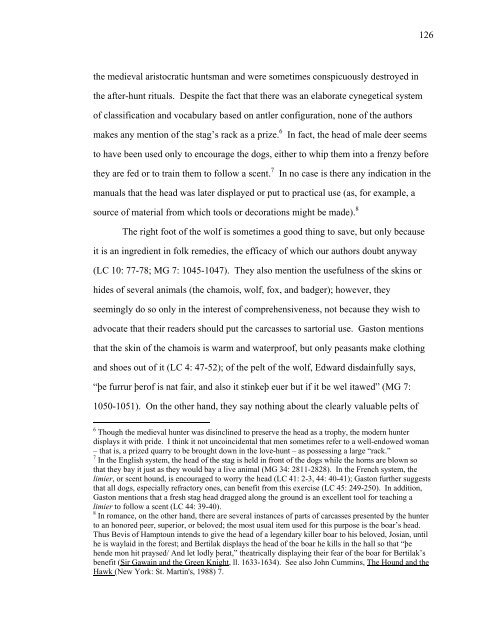Chapter 4 The Gift.pdf - eCommons@Cornell
Chapter 4 The Gift.pdf - eCommons@Cornell
Chapter 4 The Gift.pdf - eCommons@Cornell
You also want an ePaper? Increase the reach of your titles
YUMPU automatically turns print PDFs into web optimized ePapers that Google loves.
the medieval aristocratic huntsman and were sometimes conspicuously destroyed in<br />
the after-hunt rituals. Despite the fact that there was an elaborate cynegetical system<br />
of classification and vocabulary based on antler configuration, none of the authors<br />
makes any mention of the stag’s rack as a prize. 6 In fact, the head of male deer seems<br />
to have been used only to encourage the dogs, either to whip them into a frenzy before<br />
they are fed or to train them to follow a scent. 7 In no case is there any indication in the<br />
manuals that the head was later displayed or put to practical use (as, for example, a<br />
source of material from which tools or decorations might be made). 8<br />
<strong>The</strong> right foot of the wolf is sometimes a good thing to save, but only because<br />
it is an ingredient in folk remedies, the efficacy of which our authors doubt anyway<br />
(LC 10: 77-78; MG 7: 1045-1047). <strong>The</strong>y also mention the usefulness of the skins or<br />
hides of several animals (the chamois, wolf, fox, and badger); however, they<br />
seemingly do so only in the interest of comprehensiveness, not because they wish to<br />
advocate that their readers should put the carcasses to sartorial use. Gaston mentions<br />
that the skin of the chamois is warm and waterproof, but only peasants make clothing<br />
and shoes out of it (LC 4: 47-52); of the pelt of the wolf, Edward disdainfully says,<br />
“þe furrur þerof is nat fair, and also it stinkeþ euer but if it be wel itawed” (MG 7:<br />
1050-1051). On the other hand, they say nothing about the clearly valuable pelts of<br />
6 Though the medieval hunter was disinclined to preserve the head as a trophy, the modern hunter<br />
displays it with pride. I think it not uncoincidental that men sometimes refer to a well-endowed woman<br />
– that is, a prized quarry to be brought down in the love-hunt – as possessing a large “rack.”<br />
7 In the English system, the head of the stag is held in front of the dogs while the horns are blown so<br />
that they bay it just as they would bay a live animal (MG 34: 2811-2828). In the French system, the<br />
limier, or scent hound, is encouraged to worry the head (LC 41: 2-3, 44: 40-41); Gaston further suggests<br />
that all dogs, especially refractory ones, can benefit from this exercise (LC 45: 249-250). In addition,<br />
Gaston mentions that a fresh stag head dragged along the ground is an excellent tool for teaching a<br />
limier to follow a scent (LC 44: 39-40).<br />
8 In romance, on the other hand, there are several instances of parts of carcasses presented by the hunter<br />
to an honored peer, superior, or beloved; the most usual item used for this purpose is the boar’s head.<br />
Thus Bevis of Hamptoun intends to give the head of a legendary killer boar to his beloved, Josian, until<br />
he is waylaid in the forest; and Bertilak displays the head of the boar he kills in the hall so that “þe<br />
hende mon hit praysed/ And let lodly þerat,” theatrically displaying their fear of the boar for Bertilak’s<br />
benefit (Sir Gawain and the Green Knight, ll. 1633-1634). See also John Cummins, <strong>The</strong> Hound and the<br />
Hawk (New York: St. Martin's, 1988) 7.<br />
126

















